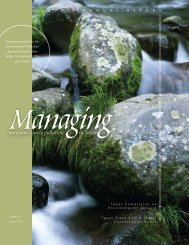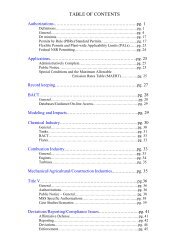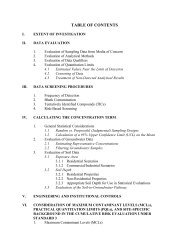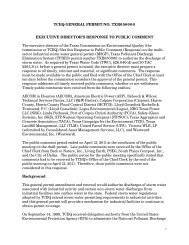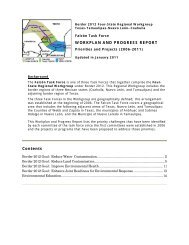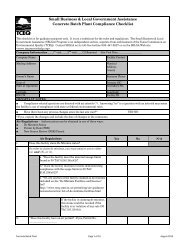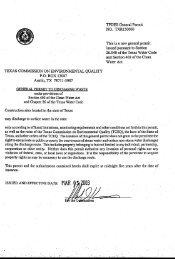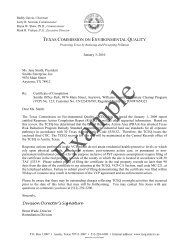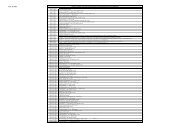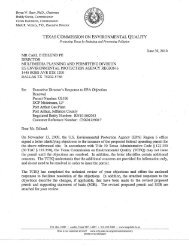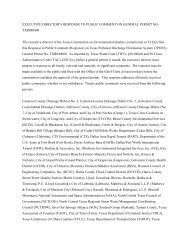TNRCC methodMETHOD 1006 - TCEQ e-Services
TNRCC methodMETHOD 1006 - TCEQ e-Services
TNRCC methodMETHOD 1006 - TCEQ e-Services
Create successful ePaper yourself
Turn your PDF publications into a flip-book with our unique Google optimized e-Paper software.
Draft <strong>TNRCC</strong> METHOD <strong>1006</strong><br />
Characterization of Nc 6 to Nc 35 Petroleum Hydrocarbons in Environmental Samples:<br />
! ALIPHATIC HYDROCARBONS<br />
! AROMATIC HYDROCARBONS<br />
! APPROXIMATE BOILING POINT/CARBON NUMBER DISTRIBUTION<br />
1.0 SCOPE AND APPLICATIONS<br />
• This method is in draft form and can be used by the laboratory provide adequate quality<br />
control data are generated and are within the acceptance criteria specified in the method.<br />
• This method is designed to separate and quantify the aliphatic and aromatic fractions in<br />
petroleum hydrocarbons extracted soil and water samples. The separation is based on<br />
approximate carbon number/boiling ranges with respect to n-alkane markers from n-<br />
hexane (nC 6 ) to n-pentatriacontane (nC 35 ). The method is applicable to hydrocarbons in<br />
the gasoline and diesel ranges and portions of the heavier fuel and lubricating oil range.<br />
This method is to be used in conjunction with <strong>TNRCC</strong> Method 1005 which is used for<br />
the determination of total petroleum hydrocarbons (See Figure 1).<br />
• This method is not intended for the quantitation of individual target analytes, such as<br />
BTEX and PAHs. Those target analytes are best determined using EPA Methods 8021,<br />
8260 or 8270, where appropriate. However, an estimate of the concentrations of<br />
individual target analytes may be obtained using this method.<br />
• Gas chromatography (GC) is used for separation with flame ionization (FID) as the mode<br />
of detection. The response of the FID is generally equal for all hydrocarbons on a weight<br />
and effective carbon number basis. The method reporting limit for TPH using <strong>TNRCC</strong><br />
Method 1005 is estimated to be 50 mg/kg in soil and 5 mg/L in water depending on the<br />
number of hydrocarbon components present in the nC 6 to nC 35 range. For this method,<br />
the soil reporting limits for each fraction range can be reported down to 10 mg/kg for soil<br />
samples and 1 mg/L for water samples. Lower reporting limits are possible depending on<br />
the distribution of hydrocarbons in each range.<br />
• This method should be used by, or under the supervision of, analysts experienced in the<br />
use of solvent extraction, solid phase fractionation and gas chromatography. The analysts<br />
should also be skilled in the interpretation of capillary gas chromatography data<br />
(specifically petroleum hydrocarbon pattern recognition), quantitation using<br />
computerized data acquisition, and use of peak processing software with baseline and<br />
peak grouping functions.<br />
• The extraction and fractionation procedure can take as little as 15 minutes to perform per<br />
sample. GC analyses may take 20 to less than 90 minutes depending on the<br />
Page 1 of 21
chromatographic column used and the GC parameters. Three separate GC analyses per<br />
sample are required to obtain data for the total petroleum hydrocarbons (as specified in<br />
<strong>TNRCC</strong> Method 1005), data for the total aliphatic fraction, and data for the total aromatic<br />
fraction. It is strongly recommended that the sample extract be analyzed first by <strong>TNRCC</strong><br />
Method 1005 to determine the type of petroleum hydrocarbons (if any) present in the<br />
sample and to review the project objectives before proceeding with the fractionation step<br />
(See Figure 1). Additionally, data from <strong>TNRCC</strong> Method 1005 can be used for potential<br />
product source identification, to assess if there are different types or distributions of<br />
petroleum hydrocarbons in a sample, or to determine if fractionation is necessary.<br />
• <strong>TNRCC</strong> Methods 1005 should be used for the purposes of determining concentrations of<br />
TPH for evaluating risk and/or determining the composition of TPH. <strong>TNRCC</strong> Method<br />
<strong>1006</strong> can be used on selected samples to determine the mass of TPH within defined<br />
boiling point ranges in the aliphatic and aromatic fractions of the TPH.<br />
• <strong>TNRCC</strong> Method 1005 is an n-pentane extraction followed by gas chromatography/flame<br />
ionization detection (GC/FID) analysis method that measures the concentration of<br />
hydrocarbons between nC 6 and nC 35 . The laboratory includes a nC 12 alkane marker and a<br />
nC 35 alkane marker to aid the data user in evaluating the distribution of the hydrocarbons<br />
in the TPH based on the chromatographic profile. The analytical results from <strong>TNRCC</strong><br />
Method 1005 are used to measure the concentration of TPH in the affected environmental<br />
media and to evaluate the relative distribution of the petroleum hydrocarbons in the total<br />
mixture.<br />
• <strong>TNRCC</strong> Method <strong>1006</strong> uses a silica gel column fractionation of the n-pentane extract<br />
(obtained using <strong>TNRCC</strong> Method 1005) to separate the TPH into the aliphatic<br />
hydrocarbon fraction and the aromatic hydrocarbon fraction and includes the analysis of<br />
each of these fractions by GC/FID. Quantitation is done using the <strong>TNRCC</strong> Method 1005<br />
calibration extended to nC 35 . The GC/FID analysis of the fractions separates each<br />
fraction into discrete boiling point ranges based on normal alkane markers. The boiling<br />
point ranges for each fraction are presented in Table 1. The concentration within each<br />
boiling point range (e.g., >nC 8 - nC 10 aliphatic or >nC 12 - nC 16 aromatic) is reported along<br />
with the total TPH concentration between nC 6 and nC 35.<br />
2.0 SUMMARY OF METHOD<br />
<strong>TNRCC</strong> Method 1005 involves extraction of a soil or a water sample with n-pentane and<br />
analysis of a portion of the extract using gas chromatography with a flame ionization detector<br />
(GC-FID). <strong>TNRCC</strong> Method <strong>1006</strong> is an extension of <strong>TNRCC</strong> Method 1005 for additional<br />
characterization of petroleum hydrocarbons. The fractionation of the petroleum hydrocarbon<br />
extract is accomplished by solid phase column separation of a portion of the n-pentane extract<br />
using silica (similar to EPA Method 3630) and eluting the column with additional n-pentane to<br />
obtain an aliphatic fraction followed by elution with dichloromethane to obtain an aromatic<br />
fraction. The fractions are analyzed using GC-FID as specified in <strong>TNRCC</strong> Method 1005. The<br />
Page 2 of 21
aliphatic and aromatic fractions are further characterized by subdividing the chromatographic<br />
data into approximate boiling point/carbon number ranges listed in Table 1 with respect to<br />
n-alkane.<br />
Table 1: Approximate Boiling Point/Carbon Number Ranges for <strong>TNRCC</strong> Method <strong>1006</strong>.<br />
Aliphatics<br />
Aromatics<br />
nC 6<br />
>nC 6 to nC 8 >nC 7 to nC 8 (Toluene only)<br />
>nC 8 to nC 10 >nC 8 to nC 10<br />
>nC 10 to nC 12 >nC 10 to nC 12<br />
>nC 12 to nC 16 >nC 12 to nC 16<br />
>nC 16 to nC 21 >nC 16 to nC 21<br />
>nC 21 to nC 35 >nC 21 to nC 35<br />
This method uses the same calibration curve as <strong>TNRCC</strong> Method 1005 that uses a 1:1 mixture of<br />
gasoline and diesel for calibration. However, either a mixture of petroleum products (such as<br />
gasoline or diesel) or single hydrocarbon components can be used for calibration. The choice of<br />
calibration standards should be the same for both methods. Currently, <strong>TNRCC</strong> Method 1005<br />
calibration is based on a mixture of gasoline and diesel.<br />
3.0 DEFINITIONS<br />
Total Petroleum Hydrocarbons (TPH) are defined in <strong>TNRCC</strong> Method 1005 as all gas<br />
chromatographic peaks detected using flame ionization detection eluting after the solvent<br />
(n-pentane) starting with and including n-hexane(nC 6 ) to n-pentatriacontane (nC 35 ). This<br />
definition includes aliphatic and aromatic hydrocarbons. The petroleum hydrocarbons in a<br />
sample (if any) may not be distributed throughout the entire range. This information is useful for<br />
product or source identification. There may be non-hydrocarbon compounds that elute in this<br />
range (such as chlorinated solvents, ketone, alcohols, etc.). However, such compounds usually<br />
appear as discrete peaks and do not match typical petroleum product fingerprints.<br />
Aliphatic Hydrocarbons are defined in this method as those compounds detected from<br />
n-hexane (nC 6 ) to n-pentatriacontane (nC 35 ) (inclusive) in the chromatogram of the aliphatic<br />
fraction.<br />
Aromatic Hydrocarbons are defined in this method as those compounds detected from<br />
n-heptane (nC 7 ) to the retention time of n-pentatriacontane (nC 35 ) in the chromatogram of the<br />
aromatic fraction. The first aromatic compound in this range is toluene. However, this method is<br />
recommended to detect aromatics starting with the C 8 to C 10 range. Benzene and toluene (nC 6 to<br />
nC 8 range) should be measured using EPA Methods 8260 or 8021 which are more selective to<br />
these compounds and have lower detection limits. If ethylbenzene and xylenes are required to be<br />
specifically identified and to be quantitated as individual components, then they should also be<br />
determined using EPA Methods 8260 or 8021.<br />
Page 3 of 21
Approximate Boiling Point/Carbon Number Distribution is defined as the subdivision of the<br />
chromatogram into sections that correspond to the approximate boiling point and/or volatility of<br />
n-alkanes. The gas chromatographic separation is achieved using a column that separates<br />
components based primarily on boiling point differences. This separation can be correlated to<br />
approximate carbon number. For example, >nC 7 to nC 8 indicates those hydrocarbons that elute<br />
after n-heptane and up to and including n-octane. This range includes most, but not all, of the C 8<br />
hydrocarbons. Branching lowers the boiling points of hydrocarbons relative to their n-alkane<br />
isomers. Cyclization, or ring structures, raises the boiling point higher than the n-alkanes of the<br />
same carbon number. Thus, there are some C 8 hydrocarbons that elute before n-heptane and there<br />
are some that elute after n-octane, including the aromatics ethylbenzene and the xylenes. Table<br />
2 lists the approximate boiling point ranges for the n-alkanes.<br />
This method allows for data reporting between each carbon range or for reporting within wider<br />
carbon ranges depending on data quality objectives.<br />
Table 2:<br />
Boiling points of n-alkanes used for the determination of approximate boiling<br />
point/carbon number distribution. Retention times based on GC conditions described<br />
in this method must be determined experimentally. Minimum required markers<br />
that defined the ranges of interest are shown in bold and shaded.<br />
n-Alkane<br />
Marker<br />
4.0 INTERFERENCES<br />
Boiling<br />
Point, /C<br />
n-Alkane<br />
Marker<br />
nC 6 69 nC 21 357<br />
nC 7 98 nC 22 369<br />
nC 8 126 nC 23 380<br />
nC 9 151 nC 24 391<br />
nC 10 174 nC 25 402<br />
nC 11 196 nC 26 412<br />
nC 12 216 nC 27 422<br />
nC 13 236 nC 28 431<br />
nC 14 253 nC 29 441<br />
nC 15 270 nC 30 450<br />
nC 16 287 nC 31 458<br />
nC 17 302 nC 32 467<br />
nC 18 316 nC 33 474<br />
nC 19 329 nC 34 481<br />
nC 20 343 nC 35 499<br />
Boiling<br />
Point, /C<br />
Page 4 of 21
Other organic compounds which are soluble in n-pentane and are not retained by silica and that have<br />
boiling points in the range of interest could be measured under the conditions of this method.<br />
However, if present, the characteristic petroleum hydrocarbon patterns will be altered. These<br />
compounds will be quantified as part of the TPH, but the data must be flagged as presumptively<br />
containing significant amount of such compounds. The aliphatic and aromatic fractions obtained by<br />
this method are less susceptible than the TPH obtained using <strong>TNRCC</strong> Method 1005 to interferences<br />
from some types of materials because the fractionation process may remove the interference.<br />
Sample contamination due to sample preparation may be minimized by the use of disposable<br />
glassware. High purity reagent grade or pesticide grade n-pentane, acetone and dichloromethane<br />
should also be used to minimize contamination problems. A method blank should be analyzed with<br />
each analytical batch to demonstrate that the system is free from contamination. If samples are<br />
expected to have high concentrations, it is also advised that solvent blanks be analyzed between GC<br />
runs to minimize contamination due to carryover.<br />
This method depends on correctly integrating a mass of unresolved peaks, usually found in the<br />
approximate nC 10 -nC 35 range, using a forced baseline. The resulting baseline, if drawn incorrectly,<br />
will have a significant effect on the concentration reported. It is imperative that chromatograms be<br />
checked (using a realistic scale relative to the chromatogram) for correct baseline extension. Blanks<br />
and/or a low level standard should be run to monitor for baseline drift. Peaks in the approximate<br />
nC 6 -nC 12 range are normally discrete and can be integrated valley to valley.<br />
5.0 LABORATORY EQUIPMENT AND SUPPLIES<br />
As specified in <strong>TNRCC</strong> Method 1005<br />
• Additional Glassware:<br />
- 1 cm I.D. by 10 to 20 cm glass column with glass or Teflon stopcock.<br />
- Kuderna-Danish concentrator tube or equivalent vials<br />
• Gas Chromatograph:<br />
As specified in <strong>TNRCC</strong> Method 1005<br />
6.0 REAGENTS AND STANDARDS<br />
6.1 Reagents<br />
• n-Pentane, dichloromethane, acetone, methanol: Pesticide grade or equivalent,
• Silica gel, 100/200 mesh desiccant. Before use, activate for at least 16 hours at<br />
130 o C in a shallow glass tray, loosely covered with foil.<br />
• Alumina - Neutral (5% Deactivated)<br />
6.2 Calibration & Stock Standard Solutions<br />
Unless noted, standards are prepared in n-pentane and are stored at -15 o C. Standard<br />
preparation should follow the guidelines outlined in EPA SW-846 Method 8000B. If<br />
available stock standards are purchased from commercial sources, the working standards<br />
must be in n-pentane. The calibration standards for quantitation are specified in <strong>TNRCC</strong><br />
Method 1005. Additional n-alkane marker standards are needed in this method to define the<br />
fractions listed in Table 1.<br />
• Petroleum Product Calibration Standard for Total Petroleum Hydrocarbons,<br />
Aliphatic and Aromatic Fractions: Prepared by accurately weighing approximately<br />
0.05 to 0.1 g (recorded to the nearest 0.0001 g) of unleaded gasoline and diesel #2<br />
in a 1:1 (either by volume or weight) ratio and diluting to volume with n-pentane in<br />
a 10 mL volumetric flask. Typical working concentration ranges are between 20 to<br />
5000 :g/mL. Commercially available standards can be used as well. This is the<br />
calibration standard for <strong>TNRCC</strong> Method 1005.<br />
• Approximate Boiling Point /Carbon Number Distribution Marker Standard (and<br />
Optional Aliphatic Check Stock Standard): The stock standard can be prepared by<br />
accurately weighing approximately 0.01 g (recorded to the nearest 0.0001 g) of<br />
individual n-alkanes [n-hexane (nC 6 ) through n-octacosane (nC 28 ) and<br />
n-pentatriacontane (nC 35 )] and diluting to volume with n-pentane in a 50 mL<br />
volumetric flask. This solution is diluted 1:10 with n-pentane. The approximate<br />
concentration of this stock solution is 20 :g/mL per component. Table 2 lists the<br />
boiling points of the n-alkanes. The laboratory should determine the retention times.<br />
At a minimum, the standard should contain nC 6 , nC 7 , nC 8 , nC 10 , nC 12 , nC 16 , nC 21 , nC 28<br />
and nC 35 which are the required markers for this method. Purchased standards can<br />
also be used and diluted, as appropriate with n-pentane.<br />
• Aromatic Fractionation Check Stock Standard: The stock standard can be prepared<br />
by accurately weighing approximately 0.01 g (recorded to the nearest 0.0001 g) of<br />
each of the target PNAs. (it should also include lighter aromatics such as benzene,<br />
toluene, ethylbenzene, o,m,p-xylene and cumene etc.) and diluting to volume with<br />
n-pentane in a 50 mL volumetric flask. This solution is diluted 1:10 with n-pentane.<br />
The approximate concentration of this stock solution is 20 :g/mL per component.<br />
Purchased standards can also be used and diluted as appropriate.<br />
• Petroleum Products Reference Standards: To assist in the qualitative determination<br />
of product type or "fingerprint" of a possible petroleum product(s), it is<br />
Page 6 of 21
ecommended that a library of chromatograms be generated of gasoline, kerosene,<br />
diesel, motor oil, crude oils and any other pertinent product for comparison purposes.<br />
A recommended concentration range is 1000 to 5000 ppm. These may be obtained<br />
from several chromatography supply vendors. Typical chromatograms of several<br />
petroleum products are included in the Appendix.<br />
7.0 SAMPLE COLLECTION, PRESERVATION, CONTAINERS, AND HOLDING<br />
TIMES<br />
Follow guidelines in <strong>TNRCC</strong> Method 1005. A summary of pertinent information is listed<br />
below.<br />
Soil samples should be collected in preweighed VOA vials with PTFE lined caps if the<br />
samples are suspected to contain hydrocarbons in the nC 6 to nC 12 boiling point/carbon range.<br />
If hyrdrocarbons within that boiling point/carbon range are not suspected, the soil sample<br />
can be collected in wide-mouth glass jars. Soil samples can also be collected and transported<br />
in core sampling devices that are designed to be hermetically sealed. Samples are stored at<br />
4/C from the time of collection until extraction. The extract can be held tightly capped at -<br />
15°C for 28 days from the day of collection.<br />
Water samples - Refer to <strong>TNRCC</strong> Method 1005.<br />
8.0 PROCEDURES<br />
8.1 Sample Extraction<br />
Refer to <strong>TNRCC</strong> Method 1005 for extraction procedure.<br />
8.2 Extract Fractionation<br />
Fractionate the extract into aliphatic and aromatic components by the following<br />
procedure:<br />
• Prepare the column by placing approximately 1 cm of moderately packed glass<br />
wool at the bottom of the column. Assemble the stopcock making sure that it<br />
turns smoothly.<br />
• Fill the column with about 10 mL of dichloromethane. Add approximately 3<br />
grams of activated silica gel to the column. Ensure that it is packed uniformly by<br />
gently tapping the side of the column. Top the column with approximately 0.5 cm<br />
of sodium sulfate. Then rinse the column with at least 10 additional mL of<br />
dichloromethane. Let the solvent flow through the column until the head of the<br />
liquid in the column is just above the top of the column (sodium sulfate nearly<br />
exposed). Discard the eluted dichloromethane. Add about 2 mL of n-pentane.<br />
Page 7 of 21
Open the stopcock and let the solvent flow until the liquid in the column is just<br />
above the top of the column. Add 10-20 mL of n-pentane in the same manner just<br />
described. Open the stopcock and let the n-pentane flow until the head of the<br />
liquid is just above the top of the column. Discard the eluant. The column is ready<br />
for use. The column may be used for fractionating additional samples after rinsing<br />
with 10-20 mL of dichloromethane followed by 2 mL of n-pentane and then<br />
10-20 mL n-pentane.<br />
Note: The performance of the silica gel is dependent on the particular lot<br />
number of silica gel from the manufacturer, the humidity of the laboratory<br />
environment, and the activation temperature. Each laboratory may need to<br />
raise or lower the activation temperature depending on their particular<br />
conditions to achieve optimal separation.<br />
• Add 1 mL of the sample extract to the column. Open the stopcock and start<br />
collecting the eluant immediately in a 10 mL Kuderna-Danish concentrator tube<br />
or an equivalent graduated vial. When the head of the n-pentane extract nearly<br />
reaches the top of the silica gel column, add n-pentane to the column in 1-2 mL<br />
increments while continuing to collect the eluant. It is best to add the solvent<br />
gently in a nearly dropwise fashion with a pipette or wash bottle allowing the<br />
solvent to run down the inner wall of the column. Continue this approach until<br />
approximately 10 mL of the eluant is collected. Label this fraction "aliphatics".<br />
• Once the 10 mL of the n-pentane (aliphatic) fraction has been collected, use<br />
another Kuderna-Danish concentrator tube, or an equivalent graduated vial, to<br />
begin collecting the aromatic fraction by elution of dichloromethane. This is done<br />
in the same manner as above by collection of the eluant immediately after<br />
addition of the dichloromethane in 1-2 mL increments or dropwise. It is critical<br />
that the first 3-4 mL be added carefully and slowly. Once 10 mL have been<br />
collected, label this fraction "aromatics". A 1:1 mixture of dichloromethane and<br />
acetone can be used to elute aromatics in some cases if difficulties are<br />
encountered with the recoveries of the heavier aromatic fractions.<br />
• Fractionation of neat petroleum products, crude oil and wastes is done by directly<br />
placing 1 drop of the sample on the silica gel column, or by weighing<br />
approximately 0.01 g of the sample, adding 1 mL of n-pentane, and then<br />
proceeding with the fractionation as described above.<br />
• When necessary, the 10 mL extracts may be reduced in volume to 1 mL by the<br />
nitrogen blowdown technique, transferred to an autosampler vial, capped and<br />
stored at -15 o C until analysis. The samples must be reextracted and refractionated<br />
if they are taken to dryness. A very slow nitrogen blowdown is necessary to<br />
minimize loss of volatiles. No heating is allowed. Concentration to 1 mL is<br />
necessary to achieve the detection limits of 50 mg/kg for soil and 5 mg/L for<br />
Page 8 of 21
water. If the TPH concentration obtained from analysis using <strong>TNRCC</strong> Method<br />
1005 is above 5000 mg/kg in soil and 500 mg/L in water, then volume reduction<br />
and concentration to 1 mL of the aliphatic and aromatic fractions is not necessary.<br />
• Silica gel capacity has not been determined. It is recommended that extraction<br />
concentrations not exceed 10,000 mg/L.<br />
The fractionation check standards (Section 6) and the blank, LCS, matrix spike and<br />
matrix spike duplicate samples must also be fractionated with the sample batch.<br />
8.3 Another Fractionation Approach<br />
A fractionation approach has been developed since the initial development of this<br />
method. It is basically the same approach but it uses a larger silica column that is more<br />
robust and less susceptible to overloading. This column uses 11 grams of activated silica<br />
gel (100/200 mesh, activated at 185/C for 8 hours) slurried with dichloromethane topped<br />
with 1 gram of alumina (5% deactivated) and 0.5 gram of sodium sulfate. The column is<br />
conditioned with 10 mL of n-pentane. The sample is loaded as indicated in this method<br />
for the smaller column. The aliphatic fraction is eluted with 18 mL of n-pentane and the<br />
aromatic fraction is eluted with 21 mL of 1:1 n-pentane and dichloromethane mixture.<br />
8.4 Gas Chromatography<br />
• Gas Chromatographic Conditions: Refer to <strong>TNRCC</strong> Method 1005 for specific<br />
GC conditions.<br />
• Retention Time Windows: Retention time windows can be determined in two<br />
ways.<br />
S Calculate the standard deviation of each individual compound’s retention<br />
time. Refer to SW-846 8000B Section 7.6 for instructions.<br />
S<br />
A default window may be chosen. This approach is preferred over the one<br />
above because capillary columns are reliable with sufficient overall longterm<br />
stability to maintain retention time appropriately. This approach is<br />
also extremely simple. A window of ± 0.1 minutes should be adequate.<br />
The laboratory should reassess retention time windows for each standard on each GC<br />
column and whenever a new GC column is installed.<br />
The aliphatic and aromatic fractions are defined using n-alkanes as markers for the<br />
approximate boiling point/carbon number range of interest using GC. These marker<br />
compounds are defined in Table 1.<br />
Page 9 of 21
For a given range, such as >nC 8 to nC 10 , the retention time (RT) window is defined as<br />
beginning immediately after elution of the first marker compound (nC 8 ) or 0.1 minutes<br />
after its RT and ending 0.1 minutes after the RT of the ending marker compound (nC 10 ).<br />
This means that nC 8 is not included in this range and nC 10 is included in the range. The<br />
same approach for setting up RT windows is used for the other fractions. The exception<br />
is nC 6 which is its own fraction and the window should be set at its RT ± 0.1 minutes or<br />
calculated as defined in SW-846 8000B Section 7.6.<br />
8.5 Calibration<br />
• External Standard Calibration Procedure: Guidance is provided for calibration<br />
and calculations using calibration factors in <strong>TNRCC</strong> Method 1005. The same<br />
calibration curve used in <strong>TNRCC</strong> Method 1005 should be used for quantitation of<br />
the fractions (TPH, aliphatic hydrocarbons and aromatic hydrocarbons) generated<br />
using this method. This calibration factor can also be used to calculate the<br />
concentration of hydrocarbons present within the n-alkane markers used for<br />
defining the approximate boiling point/carbon number distribution. Alternatively,<br />
the boiling point distribution can be obtained from normalization of the entire<br />
chromatogram (nC 6 to nC 35 ) and determination of area percent within n-alkane<br />
markers. It is best to use a chromatographic data system to handle these<br />
calculations. A separate calibration file with the additional retention times should<br />
be established for the hydrocarbon ranges of interest to determine the<br />
approximate boiling point distribution and/or selected hydrocarbon ranges, both<br />
total and fractionated.<br />
The use of internal standards and surrogates may be considered but care must be taken to<br />
avoid potential biases in quantitation.<br />
• Continuing Calibration Verification: Before analysis can begin, the working<br />
calibration factor or calibration curve must be verified on each working day by<br />
the injection of a mid-point calibration standard. If the concentration or response<br />
for these standards varies from the standard value or predicted response by more<br />
than ± 25%, a new calibration curve should be prepared. In addition, it is<br />
advisable to check instrument performance further by analysis of a low<br />
concentration standard.<br />
% Difference = MCF - CF V x 100<br />
MCF<br />
Where: MCF = Mean calibration factor from the initial calibration<br />
CF V = Calibration factor from verification standard<br />
8.6 Product Type Identification<br />
Page 10 of 21
Chromatographic peaks with characteristic fuel fingerprints eluting between the solvent front<br />
and C 12 may indicate the presence of gasoline range. Peaks between nC 12<br />
and nC 25<br />
can<br />
possibly indicate the presence of diesel range compounds. Patterns that do not resemble<br />
either product should be noted. Weathering of petroleum hydrocarbons in the environment<br />
can greatly alter hydrocarbon distribution.<br />
Product type can be determined by visual inspection of the chromatograms. Chromatograms<br />
can become more complicated if crude oil, jet range material, or other refined products are<br />
also present. Changes upon weathering must also be considered. However, it may still be<br />
possible to determine that the contamination is due to some sort of petroleum product.<br />
Industrial solvents can interfere in the analysis; however, the chromatographic fingerprints<br />
would be noticeably different. The best approach to maximize the probability of a correct<br />
identification is to analyze reference fuels from the sample location, if available, along with<br />
the sample. These reference fuels can also be used as calibration standards if desired.<br />
Decisions should be made by the analyst to determine cutoff points for quantitation of<br />
different product ranges when contamination is caused by a combination of sources. For<br />
example, if soils are contaminated with gasoline range and diesel range materials, there is<br />
an area of overlap where certain hydrocarbon ranges are common to both types of petroleum<br />
products. A compromise cutoff for mixtures of gasoline with diesel fuel range material is jet<br />
fuel/kerosene. There is no appropriate cutoff for a mixture of gasoline with jet fuel/kerosene<br />
or mixtures of jet fuel/kerosene with diesel since there is a great deal of overlap of these<br />
products. Crude oil contamination also contains a wide range of materials. In cases where<br />
mixed products are present, it is perhaps best not to quantitate how much is due to what type<br />
of product but to simply quantitate total hydrocarbons and state the approximate carbon<br />
range observed.<br />
This method is best suited for analysis of materials up to diesel range. Heavier materials can<br />
be detected with a qualitative identification of product type but may not be quantitated<br />
effectively since portions of the material may be outside of the range measured by the<br />
method (or >C 35 ). The analyst should note in the report that heavier material may be present<br />
in a test sample.<br />
Additional information on hydrocarbon pattern interpretation is included in some of the<br />
references cited.<br />
8.7 Gas Chromatographic Analysis<br />
Samples are analyzed by GC/FID as stated in <strong>TNRCC</strong> Method 1005.<br />
8.8 External Standard Calculations<br />
For the external standard calibration procedure see <strong>TNRCC</strong> Method 1005.<br />
Page 11 of 21
8.9 Calculation of Approximate Boiling Point/Carbon Number Distribution:<br />
The approximate boiling point/carbon number distribution is calculated by normalization of<br />
sums of peak areas of portions of the chromatograms eluting between preselected retention<br />
times corresponding to carbon ranges as indicated in Table 2.<br />
9.0 QUALITY CONTROL<br />
9.1 General Requirements and Recommendations<br />
Refer to <strong>TNRCC</strong> Method 1005.<br />
• The aromatic and aliphatic fractionation check standard should be analyzed prior to<br />
reporting data by this method and with each batch of silica gel to document<br />
fractionation efficiency.<br />
9.2 Minimum Instrument QC<br />
Refer to <strong>TNRCC</strong> Method 1005.<br />
9.3 Initial and Periodic Method QC Demonstration<br />
The following should be conducted as an initial demonstration of laboratory capability, prior<br />
to the analysis of any samples. Subsequent to this initial demonstration, additional<br />
demonstrations should be conducted on a periodic basis, in response to changes in<br />
instrumentation or operations, and/or in response to confirmed or suspected systems,<br />
method, or operational problems.<br />
• Initial Accuracy and Precision: Refer to <strong>TNRCC</strong> Method 1005 for demonstration<br />
of initial proficiency.<br />
• Method Detection Limits: Refer to <strong>TNRCC</strong> Method 1005.<br />
• Fractionation: The stock solutions described in Section 6 should be used to<br />
demonstrate the capability of properly fractionating aliphatic and aromatic<br />
hydrocarbons in a sample.<br />
For the aliphatic and aromatic check standard, the sum of the fractionated carbon ranges<br />
should be 60-140% of the non-fractionated value for the aliphatic fraction and aromatic<br />
fraction, respectively. If the aliphatic and aromatic check standards are mixed and<br />
fractionated together, then the sum of the aromatic and the aliphatic fractions should also be<br />
60-140% of the TPH obtained using <strong>TNRCC</strong> 1005.<br />
Page 12 of 21
It is acceptable to encounter a 10-20% crossover of the fractions. This means that it is within<br />
the acceptance criteria for this method to have 10-20% aliphatics in the aromatic fraction and<br />
10-20% aromatics in the aliphatic fraction. Chromatograms indicating adequate and poor<br />
fractionation are included in the Appendix.<br />
NOTE:<br />
It is critical that extreme care be taken on the elution of aliphatic and<br />
aromatic fractions to optimize the fractionation process. This<br />
optimization can be achieved by allowing the extract to elute from the<br />
column as much as possible before the addition of additional solvent.<br />
Add additional solvent in small increments to the column to separate<br />
and obtain the fractions in narrow bands.<br />
The amount of n-pentane and dichloromethane used to elute the<br />
aliphatic and aromatic fractions, respectively can be optimized<br />
experimentally. Use enough n-pentane to elute all the aliphatics. For the<br />
aromatic fraction, use enough dichloromethane to ensure that all the<br />
aromatic compounds, especially the PNAs, have eluted from the column.<br />
Other solvent combinations can be used provided that adequate<br />
separation and recovery of aliphatics and aromatics can be<br />
demonstrated and the procedure used is documented by the laboratory.<br />
Each silica gel batch must be tested after preparation by running a<br />
laboratory control fractionation sample.<br />
9.4 Ongoing Method QC Demonstrations<br />
If any of the performance standards specified in Section 9.5 are not met, the problem should<br />
be corrected before further samples are analyzed. Any samples run between the last QC<br />
samples that meet the criteria and those QC samples that did not meet the acceptance criteria<br />
should be rerun. If this is not possible, the data associated with the QC samples not meeting<br />
acceptance criteria should be qualified by the laboratory and reported as suspect.<br />
9.5 Quality Control Samples<br />
QC Check<br />
Frequency criteria Frequency Criteria<br />
Method Blank 1 per analytical batch < MQL<br />
Aliphatic and Aromatic<br />
Fractionation Check<br />
Standards<br />
Laboratory Control Sample<br />
(LCS)<br />
1 per each batch of silica gel 60-140% Recovery<br />
Matrix Spike (MS)/Matrix<br />
Spike Duplicate (MSD)<br />
1 set per analytical batch 60-140% Recovery or<br />
Lab Established<br />
RPD ±20%<br />
Fractionation should be repeated for any recoveries outside of QC limits. Matrix spike<br />
recoveries outside of QC limits should be noted in a case narrative. The QC samples are<br />
fractionated into the aliphatic and aromatic ranges and percent recoveries are based on the<br />
percent recovery reported from the <strong>TNRCC</strong> 1005 analytical batch. See Appendix for<br />
example calculations. (TO BE DONE).<br />
9.6 Instrument Quality Control<br />
Refer to <strong>TNRCC</strong> Method 1005 for guidelines.<br />
9.7 Instrument Calibration<br />
Refer to <strong>TNRCC</strong> Method 1005 for guidelines.<br />
9.8 Daily Mid-Point Calibration<br />
Refer to <strong>TNRCC</strong> Method 1005 for guidelines.<br />
10.0 DATA REPORTING<br />
Reporting requirements are outlined in <strong>TNRCC</strong> Method 1005. Additional reporting guidelines are<br />
as follow:<br />
• Report the concentration of non-fractionated TPH in the nC 6 to nC 35 range. Report<br />
the concentration of aliphatic and aromatic TPH fractions by the approximate boiling<br />
point/carbon number distribution as defined in Table 1.<br />
• Report the method quantitation limits for the total TPH and the aliphatic and<br />
aromatic hydrocarbon fractions.<br />
• Chromatograms and data tables, if requested.<br />
11.0 METHOD PERFORMANCE<br />
The method has been applied to the analysis of neat crude oil, gasoline, JP-4, and diesel. In addition,<br />
the method has been used for the analysis of soil samples impacted with crude oil and with<br />
petroleum products with different degrees of weathering. Recoveries are typically 80% or better for<br />
most samples.<br />
Performance evaluation on this method to date by several laboratories is as follows:<br />
Page 14 of 21
- average accuracy of 80% with overall RSD of 6%<br />
- average accuracy of 111% with overall RSD of 10%<br />
- average accuracy of 86% and overall RSD of 21%<br />
- average accuracy of 96% and overall RSD of 18%<br />
Additional method refinement and evaluation are in progress.<br />
The reporting limit per range is influenced by the number of peaks in the range. This is inherent to<br />
petroleum hydrocarbons or any complex mixtures. It is estimated to be 10 mg/kg or lower for soil<br />
and 1 mg/L or lower for water.<br />
12.0 HEALTH, SAFETY, POLLUTION PREVENTION AND WASTE MANAGEMENT<br />
Refer to <strong>TNRCC</strong> Method 1005 for guidelines.<br />
13.0 REFERENCES<br />
1. USEPA Test Method for the Evaluation of Solid Waste (SW-846), 3rd Edition, 1996.<br />
2. Tong, H.Y., Karasek, F.W., "Flame Ionization Detector Response Factors for Compound<br />
Classes in Quantitative Analysis of Complex Organic Mixtures", Analytical Chemistry, 56,<br />
2124-2128, 1984.<br />
3. <strong>TNRCC</strong> Method 1005 - Total Petroleum Hydrocarbons, December 1997.<br />
4. API Publication Number 4599: "Interlaboratory Study of Three Methods for Analyzing<br />
Petroleum Hydrocarbons in Soils: Diesel-Range Organics (DRO), Gasoline-Range<br />
Organics (GRO), Petroleum Hydrocarbons (PHC)", June 1994.<br />
5. American Association of Railroads - Risk Management Division, Comparison of Analytical<br />
Methods for Use in Evaluating the Risk from Petroleum Hydrocarbons in Soil", prepared by<br />
Remediation Technologies, Inc., R-903, 1997.<br />
6. Total Petroleum Hydrocarbons Criteria Working Group Series, Volume 3, "Selection of<br />
Representative TPH Fractions Based on Fate and Transport Considerations", July 1997,<br />
Amherst Scientific Publishers<br />
7. USEPA Test Method for the Evaluation of Solid Waste (SW-846), Method 3630C, "Silica<br />
Gel Cleanup", 1996.<br />
8. Massachusetts Department of Environmental Protection, "Method for the Determination<br />
of Extractable Petroleum Hydrocarbons (EPH)", 1995.<br />
9. Washington State WTPH-HCID Method.<br />
10. Rhodes, I.A.L., Olvera, R.Z., Leon, J.L., Hinojosa, E.M., "Determination of Total<br />
Petroleum Hydrocarbons by Capillary Gas Chromatography", Proceedings of the<br />
Fourteenth Annual EPA Conference on Analysis of Pollutants in the Environment",<br />
Norfolk, VA 1991.<br />
11. Rhodes, I.A.L, Hinojosa, E.M., Barker, D.A., Poole, R.L, "Pitfalls Using Conventional<br />
TPH Methods for Source Identification: A Case Study", Proceedings of the Fourteenth<br />
Page 15 of 21
Annual EPA Conference on Analysis of Pollutants in the Environment", Norfolk, VA<br />
1994.<br />
12. Rhodes, I.A.L, Hinojosa, E.M., Barker, D.A., Poole, R.L, "Conventional TPH Pitfalls",<br />
Environmental Lab, December/January 1995/96.<br />
13. Dempster, H.S., Lollar B.S., Feenstra S., "Tracing Organic Contaminants in<br />
Groundwater: A New Methodology Using Compound-Specific Isotopic Analysis",<br />
Environmental Science and Technology, 1997, 31, 3193-3197.<br />
14. ASTM Method D-4547-91, "Standard Practice for sampling Waste and Soils for Volatile<br />
Organics", 1991 .<br />
15. G. Naughton, G, Douglas and H. Camp, Arthur D. Little, Cambridge, MA.<br />
Page 16 of 21
Appendix<br />
• Table A: n-Alkane Marker Compounds, BTEX and PAHs: Approximate Elution Order<br />
Within Fractions<br />
• Figure A: Typical Chromatograms of Petroleum Products<br />
• Figure B: Chromatograms Showing Proper Fractionation of Aliphatics and Aromatics<br />
• Figure C: Chromatograms Showing Poor Fractionation of Aliphatics and Aromatics<br />
Page 17 of 21
TABLE A : n-Alkane Marker Compounds, BTEX and Target PAHs. Carbon Number, Equivalent Carbon<br />
Number and Boiling Points. Note that Equivalent Carbon Number indicates approximate elution of the<br />
compounds. Actual elution order may vary and some of the heavier PAHs may not exactly follow the<br />
Equivalent Carbon correlation because of different interactions with the chromatographic phases used. The<br />
order of elution of late eluting PAHs may be somewhat different. NOTE: The determination of these individual<br />
COCs must be done using EPA Methods 8021/8260 (BTEX) and 8270 (PAHs). The information provided here is to<br />
indicate where these compounds elute with respect to the n-alkane markers.<br />
Name and Approximate Order<br />
of Elution in a Boiling Point<br />
Column like DB-1<br />
nC 6<br />
6 69 6 6 nC 6<br />
Benzene 6 80 6.50 Benzene<br />
nC 7<br />
7 98 7 7 nC 7<br />
Toluene 7 111 7.58 Toluene<br />
nC 8<br />
8 126 8 8 nC 8<br />
Ethylbenzene 8 136 8.50 Ethylbenzene<br />
m-Xylene 8 139 8.60 m-Xylene<br />
p-Xylene 8 138 8.61 p-Xylene<br />
o-Xylene 8 144 8.81 o-Xylene<br />
1,2,3-Trimethylbenzene 9 169 9.84 1,2,3-Trimethylbenzene<br />
nC 10<br />
10 174 10 10 nC 10<br />
Naphthalene 10 218 11.69 Naphthalene<br />
nC 12<br />
12 216 12 12 nC 12<br />
Acenaphthylene 12 270 15.06 Acenaphthylene<br />
Acenaphthene 12 278 15.50 Acenaphthene<br />
nC 16<br />
16 287 16 Fluorene<br />
Fluorene 13 295 16.55 16 nC 16<br />
Anthracene 14 340 19.43 Phenanthrene<br />
Phenanthrene 14 339 19.36 Anthracene<br />
Pyrene 16 360 20.80 Fluoranthene<br />
nC 21<br />
21 357 21 Pyrene<br />
Fluoranthene 16 375 21.85 21 nC 21<br />
Benzo(a)anthracene 18 435 26.37 Benzo(a)anthracene<br />
Chrysene 18 448 27.41 Chrysene<br />
Benzo(b)fluoranthene 20 481 30.14 Benzo(b)fluoranthene<br />
Benzo(k)fluoranthene 20 481 30.14 Benzo(k)fluoranthene<br />
Benzo(e)pyrene 20 493 31.17 Benzo(e)pyrene<br />
Benzo(a)pyrene 20 495 31.34 Benzo(a)pyrene<br />
Dibenz[a,h]anthracene 22 524 33.92 Indeno[1,2,3-cd]pyrene<br />
Benzo(g,h,i)perylene 21 525 34.01 Dibenz[a,h]anthracene<br />
nC 35<br />
35 499 35 Benzo(g,h,i)perylene<br />
Actual<br />
Carbon<br />
Number<br />
Boiling<br />
Point, /C<br />
Equivalent<br />
Carbon<br />
Number<br />
(EC)<br />
EC<br />
Name and Approximate<br />
Order of Elution in a<br />
Slightly More Polar<br />
Column like DB-5<br />
Page 18 of 21
Name and Approximate Order<br />
of Elution in a Boiling Point<br />
Column like DB-1<br />
Actual<br />
Carbon<br />
Number<br />
Boiling<br />
Point, /C<br />
Equivalent<br />
Carbon<br />
Number<br />
(EC)<br />
EC<br />
Name and Approximate<br />
Order of Elution in a<br />
Slightly More Polar<br />
Column like DB-5<br />
Indeno[1,2,3-cd] pyrene 21 536 35.01 35 nC 35<br />
Figure A: Typical Chromatograms of Petroleum Products<br />
Fresh Gasoline<br />
Aviation Gasoline<br />
Weathered Gasoline<br />
Jet A<br />
New Motor Oil<br />
Diesel<br />
Page 19 of 21
Figure B: Chromatograms Showing Proper Fractionation of Aliphatics and Aromatics<br />
F1 (aliphatic)<br />
Response_<br />
55000<br />
50000<br />
45000<br />
No aromatics<br />
observed in F1<br />
fraction<br />
11199736.D\FID1A<br />
nC 36<br />
40000<br />
35000<br />
30000<br />
25000<br />
20000<br />
15000<br />
10000<br />
5000<br />
0<br />
Time<br />
0.00 10.00 20.00 30.00 40.00 50.00 60.00 70.00 80.00<br />
F2 (aromatic)<br />
Response_<br />
50000<br />
11199747.D\FID1A<br />
45000<br />
40000<br />
35000<br />
30000<br />
25000<br />
20000<br />
15000<br />
10000<br />
5000<br />
0<br />
Time<br />
0.00 10.00 20.00 30.00 40.00 50.00 60.00 70.00 80.00<br />
nC 36<br />
Page 20 of 21
F1 (aliphatic)<br />
Response_<br />
60000<br />
55000<br />
50000<br />
45000<br />
40000<br />
35000<br />
30000<br />
25000<br />
20000<br />
15000<br />
10000<br />
5000<br />
0<br />
Note bleed of light<br />
aromatics (BTEX)<br />
into F1 fraction<br />
11199714.D\FID1A<br />
Time<br />
0.00 10.00 20.00 30.00 40.00 50.00 60.00 70.00 80.00<br />
F2 (aromatic)<br />
Response_<br />
40000<br />
35000<br />
Irregular distribution<br />
of PAHs indicates<br />
problem<br />
11199725.D\FID1A<br />
30000<br />
25000<br />
20000<br />
15000<br />
10000<br />
5000<br />
0<br />
Time<br />
0.00 10.00 20.00 30.00 40.00 50.00 60.00 70.00 80.00<br />
Figure C: Chromatograms Showing Poor Fractionation of Aliphatics and Aromatics<br />
Page 21 of 21



